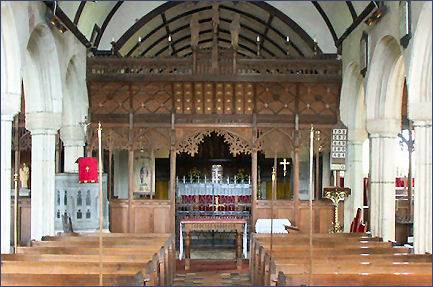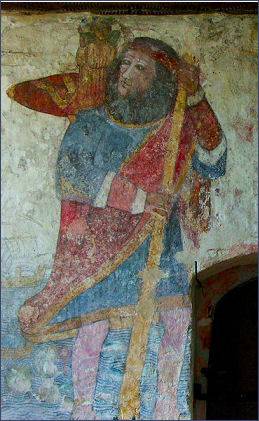Breage
OS Grid ref:-
 Breage, originally known as St Breock-in-Kirrier, lies three miles (5 km) to the west of the town of Helston. The village acquires its name from Saint Breaca, a female fifth century missionary from Ireland who was said to have been the sister of St Germoe .
Breage, originally known as St Breock-in-Kirrier, lies three miles (5 km) to the west of the town of Helston. The village acquires its name from Saint Breaca, a female fifth century missionary from Ireland who was said to have been the sister of St Germoe .
The granite village church, which is dedicated to Saint Breage or Breaca, stands on a hill with views across to the sea. The present church was probably constructed in the early twelfth century. It was considerably enlarged with north and south aisles and chapels and transepts from the mid fifteenth to the mid sixteenth centuries.
 The north wall features five remarkable medieval wall paintings (pictured right), dating to around the fourteenth century. The frescoes portray the four saints Ambrose, Christopher, Corentine and Hilary and one belonging to a style which has been labelled "Christ as Piers Plowman". It depicts a crowned near naked and wounded figure of Christ surrounded by the tools of husbandry, fishing, cloth and metal-working trades. The paintings were discovered under layers of paint in the 1950's.
The north wall features five remarkable medieval wall paintings (pictured right), dating to around the fourteenth century. The frescoes portray the four saints Ambrose, Christopher, Corentine and Hilary and one belonging to a style which has been labelled "Christ as Piers Plowman". It depicts a crowned near naked and wounded figure of Christ surrounded by the tools of husbandry, fishing, cloth and metal-working trades. The paintings were discovered under layers of paint in the 1950's.
The church of St. Breage was the burial place of Margaret, the wife of Sidney, first Earl of Godolphin, and daughter of Col. Thomas Blague. A Roman milestone of the third century is preserved in the building which bears the insvcription- IMP (C) DO NO MARC CASSI: referring to the Emperor (Marcus Cassianus) Postumus, 258-68 AD. In the churchyard stands an unusual Hiberno-Saxon cross head. Until the the time of the Reformation the church belonged to Hailes Abbey in Gloucestershire.
Tregonning Hill, where St. Breaca is allerged to have fled after her party was attacked, rises to 596 feet and Godolphin Hill at 495 feet, provide stunning views over St Ives Bay to the north and St Michael’s Mount to the south are in the parish. On the top of Tregonning Hill stand the remains of a large Iron Age fort, believed to be that of a Celtic chief named Conan which was one of the largest on Cornwall, there are no remains visible of the oratory which the saint is said to have established there. Tregonning Hill was also where William Cookworthy discovered china clay in the mid eighteenth century and was worked on a small scale for a number of years.
Breage was also associated with the mining of tin and copper in the nineteenth century. Great Work Mine sometimes known as Wheal Breage, was once 26 fathoms deep.
Nearby stands Godolphin House, one of the most fashionable houses in Cornwall in the seventeenth century, is the former seat of the Dukes of Leeds and the Earls of Godolphin. The granite Tudor and Stuart mansion is remnant of a much more extensive mansion.